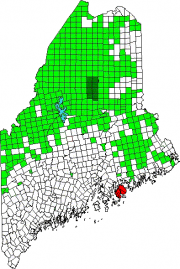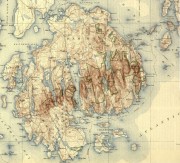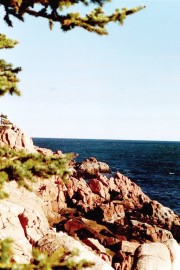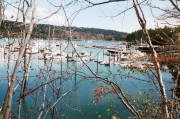[mount dez-ERT] is an island in Hancock County, containing the towns of Mount Desert, Bar Harbor, Tremont, and Southwest Harbor.
Though only 400 years have passed since Europeans first viewed it, the island has been visited by native people for thousands of years. The first were the ancestors of the so-called “Red Paint People.” Later the Abnakis, from the headwaters of the Penobscot, Machias, and Narraguagus Rivers, left their bean and corn crops to the elders and spent their summers on the island, known then as Pemetic or “sloping land.” Fishing, clamming, and making baskets from sweet grass occupied much of their time.
The first European known to have seen Mount Desert was, according to S. E. Morison (pp. 7-8), Estevan Gomes in 1525. A Portuguese sailing for Spain, he explored the Penobscot River. In 1529, Diego Ribero recorded his findings on a map which was used for about a hundred years. The “River of Mountains” noted on the map was, Morison is convinced, Somes Sound, the fjord that splits the island.
Samuel Champlain, a French navigator and cartographer, sailed by Mount Desert Island in 1604. He named it “Isles des Monts Desert”, with the accent on the last syllable, as it would be in the French language. He wasn’t implying that it was a desert. The phrase means “island of barren mountains.” That’s why it’s pronounced both as it is spelled and as the French meaning would be pronounced – dessert.
In 1613, French Jesuits, welcomed by Indians, established the first French mission in America on what is now Fernald Point, near the entrance to Somes Sound. They had just begun to build a fort when an English ship, commanded by Captain Samuel Argall, destroyed their mission.
This doomed Jesuit ambitions on Mount Desert Island, leaving it between the French to the north, and the British, whose settlements in Massachusetts and southward were increasing. For the next 150 years, Mount Desert Island’s importance was primarily as a landmark for seamen.
In 1688 it seemed Mount Desert would again become a center of French activity. Antoine Laumet, an ambitious young man who had immigrated to New France and bestowed upon himself the title Sieur de la Mothe Cadillac, asked for and received a hundred thousand acres of land along the Maine coast, including Mount Desert. Cadillac’s hopes of establishing a feudal estate in the New World, however, were short lived. He soon abandoned his enterprise but later gained fame as the founder of Detroit.
In 1759 British troops triumphed at Quebec, ending French dominion in Acadia and lands along the Maine coast opened for English settlement. Governor Francis Bernard of Massachusetts obtained a royal land grant on Mount Desert Island. In 1760, Bernard attempted to secure his claim by offering free land to settlers. Abraham Somes and James Richardson accepted the offer and settled their families at what is now Somesville at the head of Somes Sound.
The Revolutionary War ended Bernard’s plans for Mount Desert Island. In its aftermath, Bernard lost his claim, and the newly created United States of America granted the western half of Mount Desert Island to John Bernard, son of the governor, and the eastern half of the island to Marie Therese de Gregoire, granddaughter of Cadillac. Both soon sold their land to nonresident landlords.
By 1820, farming and lumbering vied with fishing and shipbuilding as major occupations. Settlers converted hundreds of acres of trees into wood products ranging from schooners and barns to baby cribs and hand tools. Farmers harvested wheat, rye, corn, and potatoes. By 1850, the familiar sights of fishermen and sailors, fish racks and shipyards, revealed a way of life linked to the sea.
It was the outsiders–artists and journalists–who revealed and popularized this island to the world in the mid-1800s. Painters of the Hudson River School, including Thomas Cole and Frederic Church, glorified Mount Desert Island with their brushstrokes, inspiring patrons and friends to flock here. These were the “rusticators”.
Undaunted by crude accommodations and simple food, they sought out local fishermen and farmers to put them up for a modest fee. Summer after summer, the rusticators returned to renew friendships with local islanders and, most of all, to savor the fresh salt air, beautiful scenery, and relaxed pace. Soon the villagers’ cottages and fishermen’s huts filled to overflowing, and by 1880, 30 hotels competed for vacationers’ dollars. Tourism was becoming the major industry.
For a select handful of Americans, the 1880s and the “Gay Nineties” meant affluence on a scale without precedent. Mount Desert, still remote from the cities of the East, became a retreat for prominent people of the times.
The Rockefellers, Morgans, Fords, Vanderbilts, Carnegies, and Astors chose to spend their summers here. Not content with the simple lodgings then available, these families transformed the landscape of Mount Desert Island with elegant estates, euphemistically called “cottages.” Luxury, refinement, and ostentatious gatherings replaced buckboard rides, picnics, and day-long hikes of an earlier era.
For over 40 years, the wealthy held sway at Mount Desert, but the Great Depression and World War II marked the end of such extravagance. The final blow came in 1947 when a fire of monumental proportions consumed many of the great estates.
Mount Desert in the late 1930s and early 1940s is captured in this amateur film from the Northeast Historic Film archives.
Today the island’s towns host tens of thousands of tourists each summer, along with year-round fishing, scientific research, and academic activities.
More Videos!
Additional resources
Acadia National Park’s Internet site http://www.nps.gov/acad/historyculture/collections.htm (accessed February 17, 2008). An abbreviated version of an earlier history entry on the Acadia site (accessed April 4, 2001) provided the basis for the article above.
Beard, Ronald Elton. An Economic Perspective on the History of Mount Desert Island. Thesis (M.S.) in Agricultural and Resource Economics–University of Maine. 1974.
DeCosta, B. F. (Benjamin Franklin), 1831-1904. Scenes in the Isle of Mount Desert, Coast of Maine. New York. 1868.
Eliot, Samuel A. The Romance of Mount Desert. 1899.
Higgins, A. L. Notes From the Early History of Mt. Desert Island Together with a Sketch Drawn from Memory of “East Eden”, Bar Harbor in the Year 1855. Bar Harbor, Me. The Author. 1929.
Library of Congress. Maps of Acadia National Park. (accessed 2/20/08) http://memory.loc.gov/ammem/gmdhtml/nphtml/acadhome.html
Morison, Samuel Eliot. The Story of Mount Desert Island.
Savage, Charles. Mount Desert: The Early French Visits. 1973.
Sawtelle, William Otis, 1874-1939. Mount Desert Island: Champlain to Bernard. Eastern National Park and Monument Association. c1994.
Stellpflug, Theresa O and Steven C. Deller. The Economic Structure of Mount Desert Island. Orono, Me. Department of Agricultural and Resource Economics. University of Maine. 1989.
Street, George Edward, 1835-1903. Mount Desert: A History. Edited by Samuel A. Eliot. Salem, Mass. Higginson Book Co. 1995.







